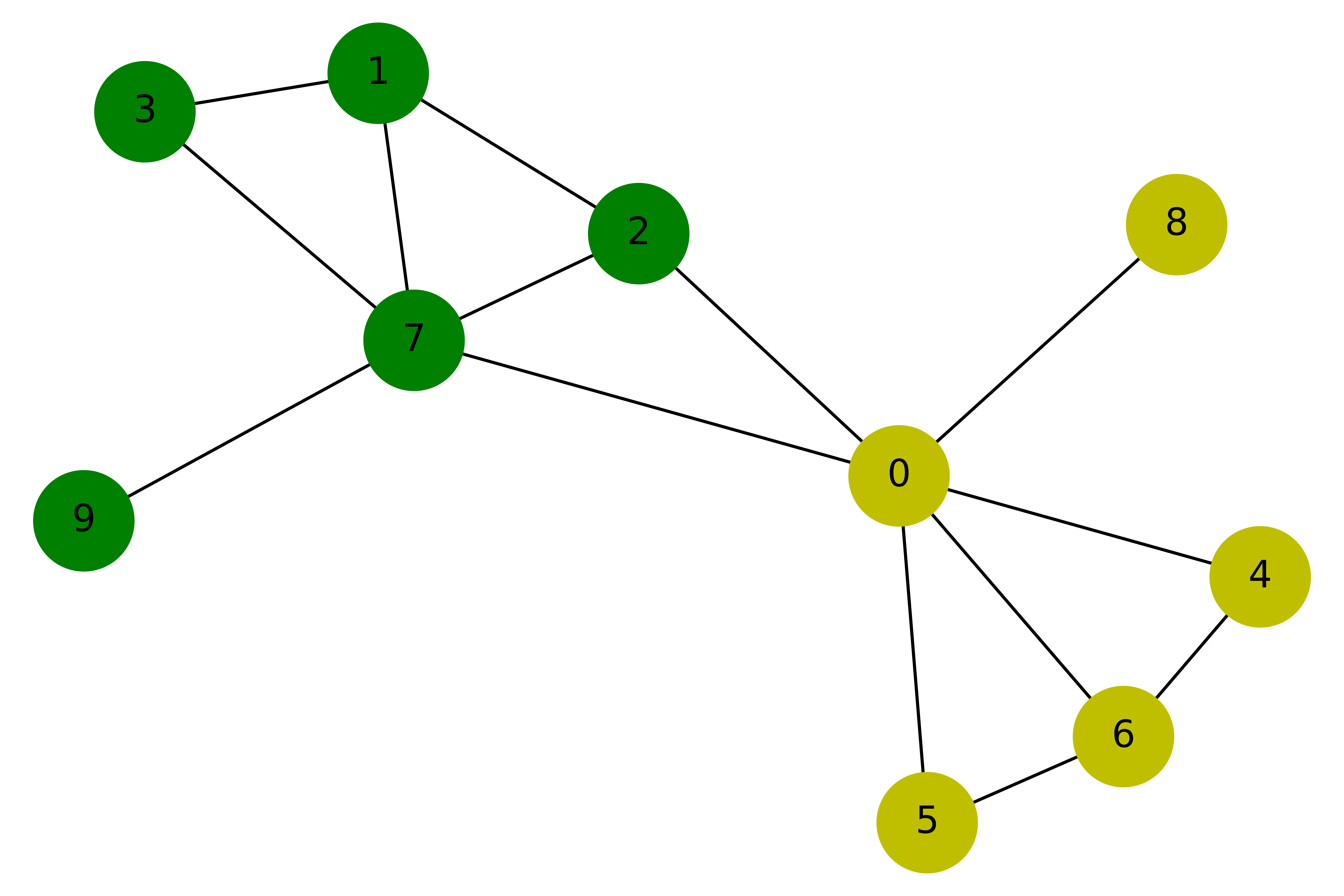Quick Start Instructions¶
Install PGL¶
To install Paddle Graph Learning, we need the following packages.
paddlepaddle >= 1.6
cython
We can simply install pgl by pip.
pip install pgl
Step 1: using PGL to create a graph¶
Suppose we have a graph with 10 nodes and 14 edges as shown in the following figure:

Our purpose is to train a graph neural network to classify yellow and green nodes. So we can create this graph in such way:
import pgl
from pgl import graph # import pgl module
import numpy as np
def build_graph():
# define the number of nodes; we can use number to represent every node
num_node = 10
# add edges, we represent all edges as a list of tuple (src, dst)
edge_list = [(2, 0), (2, 1), (3, 1),(4, 0), (5, 0),
(6, 0), (6, 4), (6, 5), (7, 0), (7, 1),
(7, 2), (7, 3), (8, 0), (9, 7)]
# Each node can be represented by a d-dimensional feature vector, here for simple, the feature vectors are randomly generated.
d = 16
feature = np.random.randn(num_node, d).astype("float32")
# each edge has it own weight
edge_feature = np.random.randn(len(edge_list), 1).astype("float32")
# create a graph
g = graph.Graph(num_nodes = num_node,
edges = edge_list,
node_feat = {'feature':feature},
edge_feat ={'edge_feature': edge_feature})
return g
# create a graph object for saving graph data
g = build_graph()
After creating a graph in PGL, we can print out some information in the graph.
print('There are %d nodes in the graph.'%g.num_nodes)
print('There are %d edges in the graph.'%g.num_edges)
# Out:
# There are 10 nodes in the graph.
# There are 14 edges in the graph.
Currently our PGL is developed based on static computational mode of paddle (we’ll support dynamic computational model later). We need to build model upon a virtual data holder. GraphWrapper provide a virtual graph structure that users can build deep learning models based on this virtual graph. And then feed real graph data to run the models.
import paddle.fluid as fluid
use_cuda = False
place = fluid.CUDAPlace(0) if use_cuda else fluid.CPUPlace()
# use GraphWrapper as a container for graph data to construct a graph neural network
gw = pgl.graph_wrapper.GraphWrapper(name='graph',
node_feat=g.node_feat_info(),
edge_feat=g.edge_feat_info())
Step 2: create a simple Graph Convolutional Network(GCN)¶
In this tutorial, we use a simple Graph Convolutional Network(GCN) developed by Kipf and Welling to perform node classification. Here we use the simplest GCN structure. If readers want to know more about GCN, you can refer to the original paper.
In layer \(l\),each node \(u_i^l\) has a feature vector \(h_i^l\);
In every layer, the idea of GCN is that the feature vector \(h_i^{l+1}\) of each node \(u_i^{l+1}\) in the next layer are obtained by weighting the feature vectors of all the neighboring nodes and then go through a non-linear transformation.
In PGL, we can easily implement a GCN layer as follows:
# define GCN layer function
def gcn_layer(gw, nfeat, efeat, hidden_size, name, activation):
# gw is a GraphWrapper;feature is the feature vectors of nodes
# define message function
def send_func(src_feat, dst_feat, edge_feat):
# In this tutorial, we return the feature vector of the source node as message
return src_feat['h'] * edge_feat['e']
# define reduce function
def recv_func(feat):
# we sum the feature vector of the source node
return fluid.layers.sequence_pool(feat, pool_type='sum')
# trigger message to passing
msg = gw.send(send_func, nfeat_list=[('h', nfeat)], efeat_list=[('e', efeat)])
# recv funciton receives message and trigger reduce funcition to handle message
output = gw.recv(msg, recv_func)
output = fluid.layers.fc(output,
size=hidden_size,
bias_attr=False,
act=activation,
name=name)
return output
After defining the GCN layer, we can construct a deeper GCN model with two GCN layers.
output = gcn_layer(gw, gw.node_feat['feature'], gw.edge_feat['edge_feature'],
hidden_size=8, name='gcn_layer_1', activation='relu')
output = gcn_layer(gw, output, gw.edge_feat['edge_feature'],
hidden_size=1, name='gcn_layer_2', activation=None)
Step 3: data preprocessing¶
Since we implement a node binary classifier, we can use 0 and 1 to represent two classes respectively.
y = [0,1,1,1,0,0,0,1,0,1]
label = np.array(y, dtype="float32")
label = np.expand_dims(label, -1)
Step 4: training program¶
The training process of GCN is the same as that of other paddle-based models.
First we create a loss function.
Then we create a optimizer.
Finally, we create a executor and train the model.
# create a label layer as a container
node_label = fluid.layers.data("node_label", shape=[None, 1],
dtype="float32", append_batch_size=False)
# using cross-entropy with sigmoid layer as the loss function
loss = fluid.layers.sigmoid_cross_entropy_with_logits(x=output, label=node_label)
# calculate the mean loss
loss = fluid.layers.mean(loss)
# choose the Adam optimizer and set the learning rate to be 0.01
adam = fluid.optimizer.Adam(learning_rate=0.01)
adam.minimize(loss)
# create the executor
exe = fluid.Executor(place)
exe.run(fluid.default_startup_program())
feed_dict = gw.to_feed(g) # gets graph data
for epoch in range(30):
feed_dict['node_label'] = label
train_loss = exe.run(fluid.default_main_program(),
feed=feed_dict,
fetch_list=[loss],
return_numpy=True)
print('Epoch %d | Loss: %f'%(epoch, train_loss[0]))